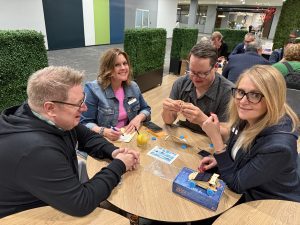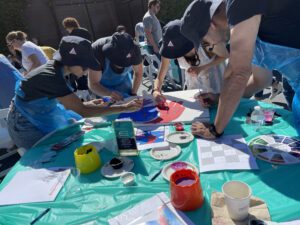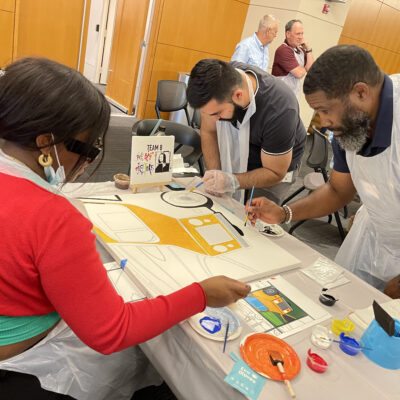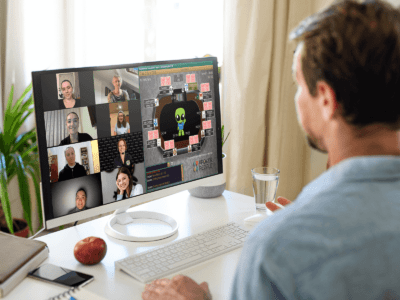Workplace conflict isn’t just inevitable; it’s also instructive. It points to where trust is fraying, expectations are misaligned, and communication needs work. But resolving it takes more than surface-level fixes. The good news? Conflict resolution team building activities can turn tension into teamwork.
But it has to go deeper than trust falls and surface-level feedback. As psychologist and author Dr. Jessica Stern shared on Team Building Saves the World, “One of the main reasons why people go into therapy is similar to why I think a lot of people decide to exit a workplace, which is difficult relationships.” It’s not the conflict itself that ruins work culture. It’s the consequence of ignoring that conflict.
In this post, we’ll use insights from Dr. Stern’s interview on the Team Building Saves the World podcast to explore how empathy, structure, and team building can improve how your team navigates conflict without letting it fester.
Why Conflict Happens—And What You Can Do About It
Workplace conflict typically begins with miscommunication, but that’s just the surface. According to Dr. Stern, many interpersonal conflicts are actually driven by something deeper: insecure attachment patterns, a lack of psychological safety, and mismatched expectations. She explains that “People have different interpersonal patterns… they’re coming to work with different expectations around relationships.”
Some team members arrive assuming the best in others. Others are wired to expect criticism or feel like they’re constantly under scrutiny. That’s why the same piece of feedback can land as neutral to one person and feel deeply personal to another. When those unspoken patterns go unchecked, tension builds. Misunderstandings escalate. Trust erodes.
Here are just a few of the most common culprits:
- Ambiguous communication
- Unclear roles or expectations
- Over-reliance on Slack, email, or asynchronous tools
- Passive-aggressive behavior
- Generational differences in communication styles
Sound familiar? You’re not alone and, thankfully, there’s a way through it. It starts with empathy.
What role does empathy really play in workplace conflict?
Stern breaks empathy down into two types:
- Emotional empathy: You can feel what someone else is feeling, without becoming overwhelmed by it.
- Cognitive empathy: You can see things from another person’s point of view, even if you disagree.
She believes that “Empathy can be a superpower… Emotional empathy reduces aggression. Cognitive empathy allows for more creativity.” Both types of empathy are essential for navigating conflict without making it worse. And yes, you can build them. Dr. Stern recommends two surprisingly simple methods:
- Be curious, especially about difficult people. Ask them questions that shift the conversation away from conflict and toward connection.
- Read fiction or memoirs. Studies show reading fiction increases cognitive empathy by helping you step into another person’s shoes.
Of course, empathy isn’t enough on its own. The most effective teams pair empathy with structure—especially when it comes to feedback.
Are you creating a culture where feedback actually works?
A strong feedback culture doesn’t happen automatically. It’s something you design and that starts with managers creating predictable, safe structures for two-way conversations. For Dr. Stern, it’s important to remember that “feedback has to be mutual. It has to be a two-way street.”
When employees know they’ll be asked how things are going, and then when they see their feedback is acted on, they’re more likely to surface issues early, before things begin to spiral.
Use these questions to assess your own feedback culture:
- Do employees have recurring, structured spaces to give feedback upward?
- Is feedback encouraged from day one, or only in crises?
- Are there rituals that help normalize reflection and repair?
If not, conflict resolution team building activities can provide a low-stakes way to model mutual feedback, curiosity, and repair.
5 Conflict Resolution Strategies You Can Start Using Today
You don’t need to wait for a conflict to become toxic before taking action. In fact, the most effective teams use small, repeatable behaviors to keep communication open, build trust, and prevent tension from spiraling.
Here are five practical strategies to begin using right away, whether you’re managing a remote team, leading a workshop, or just navigating a tense meeting.
1. Practice Active Listening (Really)
It’s easy to assume you’re a good listener. But in conflict, most people aren’t actually listening. They’re waiting to talk. Active listening is about tuning in, not just nodding along.
Start by removing distractions. If the conversation matters, make eye contact, close your laptop, and be fully present. Let the other person speak without interruption. Once they finish, reflect back what you heard using their own words.
This isn’t to parrot their thoughts back to them but to clarify and affirm. You can say, “What I’m hearing is that you’re frustrated about the way the deadline was handled, especially since it wasn’t communicated clearly. Is that right?”
This kind of validation doesn’t mean you agree, but it does mean you’re working to understand. That small shift builds trust and creates emotional safety, which is the foundation of all effective conflict resolution.

2. Name the Shared Goal
Conflict often feels personal, but more often than not, you’re arguing about how to get somewhere, not where you’re going.
When you’re in a tense conversation, pause and bring the focus back to a shared goal:
- “I know we’re both trying to deliver the best product to our clients.”
- “At the end of the day, we both want our team to succeed.”
- “We’re both under pressure, and I think we want the same thing: a clear plan forward.”
When people feel seen and aligned, it diffuses defensiveness. It’s no longer you against them. It’s both of you tackling the problem together. This is especially powerful during activities that are designed to address conflict management, like live-action escape games or strategy-based collaboration programs where teammates must align quickly under time constraints.
3. Invite Feedback and Then Act On It
Inviting feedback isn’t brave. Acting on it is. Too many teams conduct pulse surveys or feedback sessions that go nowhere. The result? Employees feel like their voices don’t matter and they stop speaking up.
Dr. Stern emphasizes that mutual feedback is one of the clearest predictors of trust and long-term collaboration. A strong feedback loop isn’t just reactive. It’s proactive. That means building space into your workflows where people expect to give and receive feedback regularly, not just after things go wrong.
Here’s what that might look like:
- Managers kick off 1:1s by asking, “What’s one thing I could be doing differently?”
- Team retros include a “stop/start/continue” segment with anonymous input.
- Leaders circle back on feedback with updates: “You mentioned we needed clearer meeting agendas. I’ve started sending those out a day in advance. Let me know if it’s helping.”
4. Move Before You Mediate
It’s hard to think clearly when your body is in fight-or-flight mode. Physical movement is one of the simplest and most effective ways to regulate that response. Dr Stern strongly advocates that even a 5 minute walk around the office can completely change the way you deal with conflict.
This is because movement helps reset your nervous system so you can return to the conversation more grounded and less reactive. Teams that schedule “walk and talks” or lunchtime movement breaks often report higher creativity and lower interpersonal tension.
This is also why so many of our conflict resolution team building activities (like scavenger hunts, outdoor charitable events, or immersive games) take place on their feet. The energy of movement opens people up in ways sitting in a boardroom never will.
5. Practice the Art of Repair
When conflict happens, most people avoid it or over-apologize. Neither builds trust. Instead, try learning the language of repair statements. Repair statements aren’t about blame. Rather, the focus is on clarity, ownership, and commitment.
A basic repair statement follows three steps:
- Acknowledge impact: “I know that came across as dismissive.”
- State intent: “That wasn’t my goal. I was trying to keep us on track.”
- Offer adjustment: “Next time I’ll pause to make sure everyone’s had a chance to weigh in.”
Try incorporating a repair moment at the end of your team’s weekly huddles or retrospectives. Ask, “Was there anything this week we want to clear the air about?” It normalizes real-time course correction and helps prevent long-term rifts.
Conflict Resolution Team Building Activities That Actually Work
The best time to build conflict skills isn’t when everything is on fire. It’s when things are calm enough to experiment, reflect, and grow. That’s where team building comes in.
When designed with purpose, team building activities for workplace conflict resolution create space for your team to:
- Strengthen communication
- Learn how others think under pressure
- Build muscle memory for feedback and recovery
Here are four highly effective programs that build these skills in fun, experiential ways:
1. Donation Station
Great for: Perspective sharing, building empathy across teams
In this CSR-driven event, teams assemble essential kits for communities in need while learning about the people they’re helping. As teammates work together to complete the challenge, they often surface personal stories and build empathy that carries back into their daily collaboration.
2. Meal Pack Give Back
Great for: Coordination under pressure, practicing calm in chaos
This program turns food insecurity into a rallying point for connection. Teams work in assembly-line style to package meals, meaning every role depends on another. It mirrors real workplace dynamics where small miscommunications can cause big delays. It invites teams to slow down, sync up, and build coordination through problem solving team building exercises they’ll remember long after the event ends.
3. Hope for the Holidays
Great for: Reflecting, storytelling, connecting across departments
Holiday stress is real and so is year-end burnout. This activity infuses meaning into seasonal giving by connecting teams to stories, values, and gratitude. It helps teammates reconnect with purpose and each other in an emotionally safe environment.
4. The Big Picture
Great for: Aligning vision, visualizing teamwork
Each participant paints a portion of a larger mural. The catch? No one sees the full image until it comes together. It’s a metaphor in motion for collaboration, clarity, and trust, which is perfect for teams that are struggling to stay aligned.
Practice makes progress
Here’s the truth: conflict isn’t a sign that your team is broken. It’s a sign that your team is made of humans. But when you normalize empathy, practice feedback, and build space for structured team building, you stop avoiding conflict and start navigating it with skill, especially when you’ve built in regular conflict and resolution activities that make those skills second nature.
Even normalizing small things, like telling your boss you need to take a walk before you resume your conversation because it will calm you down, can make a difference, says Dr. Stern. It’s the small steps that begin a culture change.
Ready to build a more resilient culture?
Explore our full catalog of programs designed to help teams communicate better, build trust faster, and grow through conflict resolution team building activities tailored to your workplace challenges. Every event is customizable, fully facilitated, and rooted in the power of play.
Let’s help your team turn tension into teamwork.

















